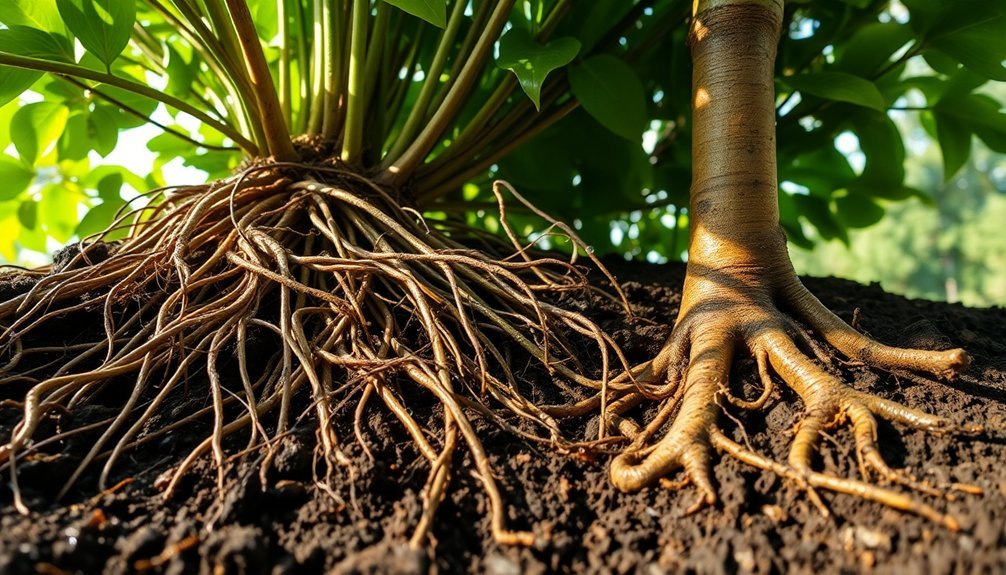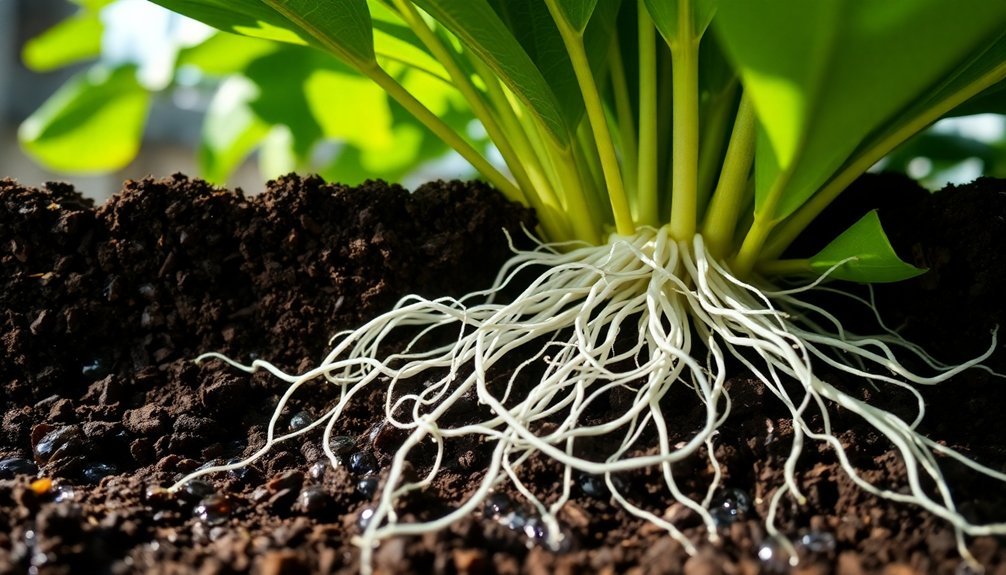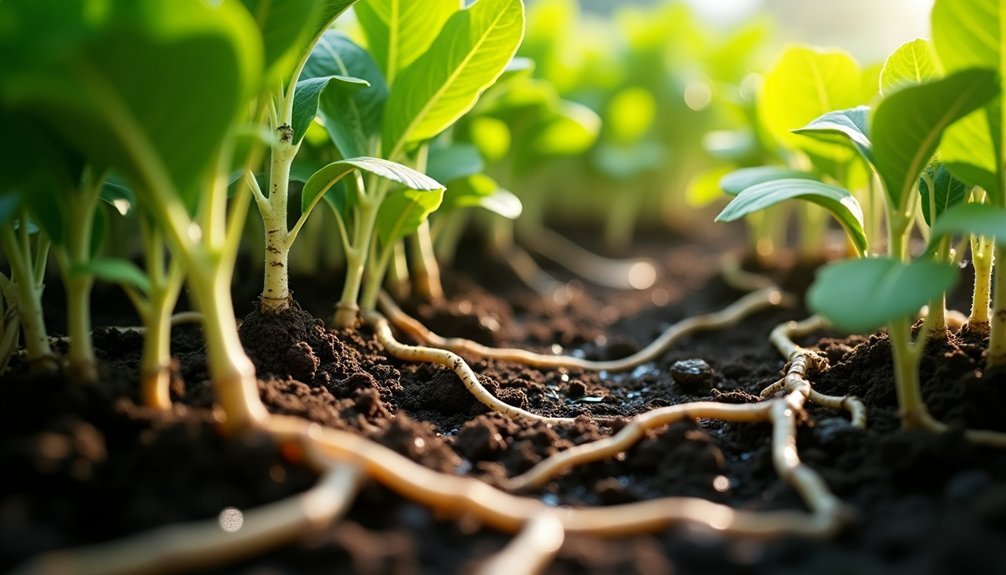Your plant's root system acts as a natural guide for watering needs. You'll find two main types: fibrous roots that absorb surface moisture and tap roots that reach deep into the soil. Shallow watering creates weak, surface-level roots, while deep watering encourages stronger roots that extend downward for better drought resistance. By observing how roots respond to different watering methods, you'll discover the secrets to growing healthier, more resilient plants.
Understanding Root Architecture and Water Absorption

While plants may appear simple above ground, their root systems form intricate networks that excel at water absorption through specialized structures and growth patterns.
You'll find two main types of root systems: fibrous roots that capture moisture near the surface, and tap roots that reach deep into the soil for water access.
Root hairs dramatically boost your plant's ability to absorb water by increasing the surface area for absorption. These tiny structures work together with the main root system to maximize water uptake.
When you practice deep watering, you're encouraging roots to grow downward, helping them access moisture and nutrients from lower soil levels.
This adaptation is remarkable – roots can sense where water is located and adjust their growth patterns accordingly, ensuring your plants develop strong, resilient root systems.
Deep vs. Shallow Watering Impact on Root Growth
Although both watering methods can sustain plants, deep and shallow watering create distinctly different root growth patterns.
When you water deeply, you're encouraging roots to grow downward, helping them access more moisture and nutrients in lower soil layers. This develops a robust, extensive root system that makes your plants more resilient during dry periods.
In contrast, shallow watering leads to shorter roots that stay near the surface, making your plants dependent on frequent watering. You'll find these surface-level roots are more vulnerable to drought stress since the top layer of soil dries quickly.
Your plants' roots naturally grow toward moisture, so when you water deeply, they'll extend further into the soil where water is retained longer. This creates a stronger foundation for your plants' long-term health and stability.
Root System Types and Their Watering Needs

Different root system types fundamentally shape how you should water your plants.
If you're tending to plants with fibrous roots, you'll need to water more frequently but with less volume, as these branching roots excel at absorbing moisture from the upper soil layers.
In contrast, plants with tap roots require deeper, less frequent watering to reach their extensive root systems that stretch far into the soil.
You'll find that adventitious roots, which grow from stems or leaves, need similar care to fibrous systems due to their surface-level presence.
When managing various root types in your garden, it's essential to monitor soil moisture levels carefully.
You'll want to avoid over-saturating fibrous-rooted plants while ensuring tap-rooted ones receive enough water to promote deep root development.
Seasonal Changes in Root Water Requirements
As seasons shift throughout the year, you'll need to adjust your watering schedule to match your plants' changing requirements.
During spring, water deeply every two weeks to support newly planted trees and other vegetation as they develop fresh roots.
When summer arrives, you'll need to increase watering frequency to twice weekly due to higher temperatures and increased plant water demands.
As autumn approaches, return to a spring-like schedule, gradually reducing your watering to monthly sessions.
Winter requires the least attention, with just one deep watering per month, unless your ground is frozen.
Throughout these seasonal changes, remember that temperature fluctuations, moisture levels, and plant growth stages all influence how much water your plants' roots require.
Adjust your watering practices accordingly to maintain healthy root systems.
Signs of Healthy Root Development Through Proper Watering

Understanding visible signs of healthy root development helps you determine if your seasonal watering efforts are paying off. When you water deeply, you'll promote robust root systems that efficiently absorb nutrients from lower soil layers. Look for white, actively growing root hairs as a key indicator of proper development.
| Sign | What It Means | Action Required |
|---|---|---|
| White Root Hairs | Active Growth | Continue Current Watering |
| Deep Root Growth | Good Resource Access | Maintain Deep Watering |
| Flexible Roots | Healthy Adaptation | Monitor Soil Moisture |
You'll notice enhanced nutrient uptake when roots grow extensively throughout the soil profile. Monitor your soil's moisture levels regularly to prevent overwatering, which can harm root health. Plants with well-developed root systems show better drought resistance, confirming that your watering technique is effective.
Root Zone Moisture Management Techniques
Testing your soil moisture at a 4-inch depth lets you know exactly when it's time to water, ensuring you're not under or overwatering your plants.
You'll want to implement deep watering techniques that reach at least 8 inches down, which you can achieve through slow-drip irrigation systems or manual methods that allow water to penetrate gradually.
While sandy soils need more frequent deep watering than clay soils, you can maintain ideal moisture levels year-round by adjusting your watering schedule to seasonal changes and applying a thick layer of mulch to reduce evaporation.
Moisture Testing Methods
Proper moisture testing in your plant's root zone can make the difference between thriving and struggling plants.
You'll need to understand how moisture moves through different soil types to water effectively.
Using a trowel, check the soil moisture at 4 inches deep – if it's slightly moist, you'll need to water deeply.
For more precise measurements, use a soil probe to assess moisture throughout the root zone. This tool helps you determine exactly when to water based on your specific soil conditions.
Don't forget to take core samples from various depths. While the surface might appear dry, deeper layers could still retain adequate moisture.
This is especially important since clay and sandy soils hold water differently. Regular testing guarantees your plants' roots can access the water and nutrients they need.
Root Depth Watering Strategies
When you water deeply and consistently, plants develop stronger, more extensive root systems that can better survive environmental stresses.
Deep watering techniques guarantee moisture penetrates 6-8 inches into the soil, encouraging roots to grow downward rather than staying near the surface.
Check soil moisture at 4-inch root depth to determine best watering timing. For new trees and shrubs, apply 1 inch of water weekly, focusing on both the root ball and surrounding soil.
Understand that different plants have varying needs – fibrous-rooted plants prefer frequent, light watering, while tap-rooted plants thrive with less frequent but deeper soaking.
Adjust your watering schedule seasonally. You'll need to water every two weeks in spring, increasing to twice weekly during hot summer months to maintain proper root zone moisture.
Seasonal Moisture Adjustments
Successful root zone moisture management requires strategic adjustments throughout the growing season.
You'll need to adapt your deep watering schedule based on seasonal changes and your soil's characteristics. In spring, water deeply every two weeks to promote healthy root development, while summer demands more frequent watering up to twice weekly due to increased evaporation.
- Monitor soil moisture at 4 inches deep to determine ideal watering timing
- Increase watering frequency during hot summer months when plants need more moisture
- Reduce deep watering to monthly sessions during autumn's slower growth period
- Consider your soil type – clay retains water longer than sandy soil
- Maintain consistent moisture levels to encourage roots to grow deeper
Root Response to Different Watering Methods
Your watering methods directly influence how your plant's roots grow, with deep watering encouraging roots to extend further into the soil while shallow watering results in shorter, surface-level root systems.
When you water deeply, roots actively seek out moisture in lower soil layers, developing stronger networks that better support the plant's needs.
You'll notice your plants become more resilient to drought stress and nutrient deficiencies as their roots adapt to find water in deeper soil profiles.
Shallow Vs Deep Growth
The way you water your plants directly influences how their root systems develop and grow.
When you practice shallow watering, you're encouraging roots to stay near the surface, making them vulnerable to drought stress. In contrast, deep watering promotes stronger, more resilient root systems that can access moisture stored in lower soil layers.
Here's how different watering methods affect root development:
- Deep watering saturates soil to 6+ inches, promoting roots that extend up to two feet
- Shallow watering creates surface-dependent root systems
- Roots naturally grow toward moisture sources, so deep water encourages downward growth
- Frequent light watering leads to weak, shallow root systems
- Deep root systems better withstand dry periods by accessing stored moisture
Choose deep watering to develop robust root systems that'll help your plants thrive during drought conditions.
Water-Seeking Root Patterns
Plant roots possess a remarkable ability to sense and seek out water sources, adapting their growth patterns based on moisture availability.
You'll notice that lateral roots develop strategically, extending towards areas where they detect higher moisture levels.
When you water deeper into the soil, roots respond by growing downward, accessing nutrients and moisture reserves that aren't available near the surface.
However, if you consistently water only the surface soil, roots will remain shallow, limiting their ability to survive during dry periods.
Your watering method directly influences how roots explore their environment – they'll first spread in multiple directions, then concentrate their growth where they find consistent moisture.
Understanding this behavior helps you develop more effective watering practices that encourage robust, resilient root systems.
Roots Adapting to Moisture
Nature's remarkable adaptability becomes evident in how roots respond to various watering methods. When you water trees and shrubs consistently, their roots develop strategic growth patterns to maximize uptake of water and nutrients. Deep watering encourages roots to grow deeper into the soil, creating more stable and drought-resistant plants.
Key root adaptations include:
- Initial sensing of moisture locations from early cell division
- Balanced lateral branching to explore multiple water sources
- Directional growth adjustment based on water availability
- Enhanced depth penetration in response to deep watering practices
- Formation of extensive networks where moisture is most accessible
Understanding these adaptations helps you improve your watering techniques. When you provide water at greater depths, roots respond by developing stronger, deeper systems that better sustain your plants during dry periods.
Frequently Asked Questions
What Is Root Watering System?
You'll find that a root watering system delivers water directly to plant roots through targeted irrigation methods. It'll help your plants absorb water efficiently while promoting deeper root growth and healthier development.
What Is the Science Behind Watering Plants?
You'll encourage deeper root growth by watering deeply, as roots actively seek moisture. When you water thoroughly, it helps roots develop deeper into the soil, improving nutrient uptake and plant resilience.
What Is the Root System of a Water Plant?
You'll find water plants have specialized adventitious roots that grow from stems or leaves. They're fibrous and spread out, helping the plant stay stable, absorb nutrients efficiently, and exchange gases in aquatic environments.
What Is a Plant Watering System Called?
You'll find that a plant watering system is called an irrigation system. It's your go-to solution for delivering water to plants effectively, whether you're using drip lines, sprinklers, or soaker hoses.
In Summary
You'll get the best results by matching your watering approach to your plants' root systems. Remember that deep watering encourages deeper roots, while shallow, frequent watering leads to surface-level root development. Watch for signs like healthy growth and soil moisture levels to adjust your watering schedule. By understanding your plants' root architecture, you'll promote stronger, more resilient plants that use water efficiently.





Leave a Reply